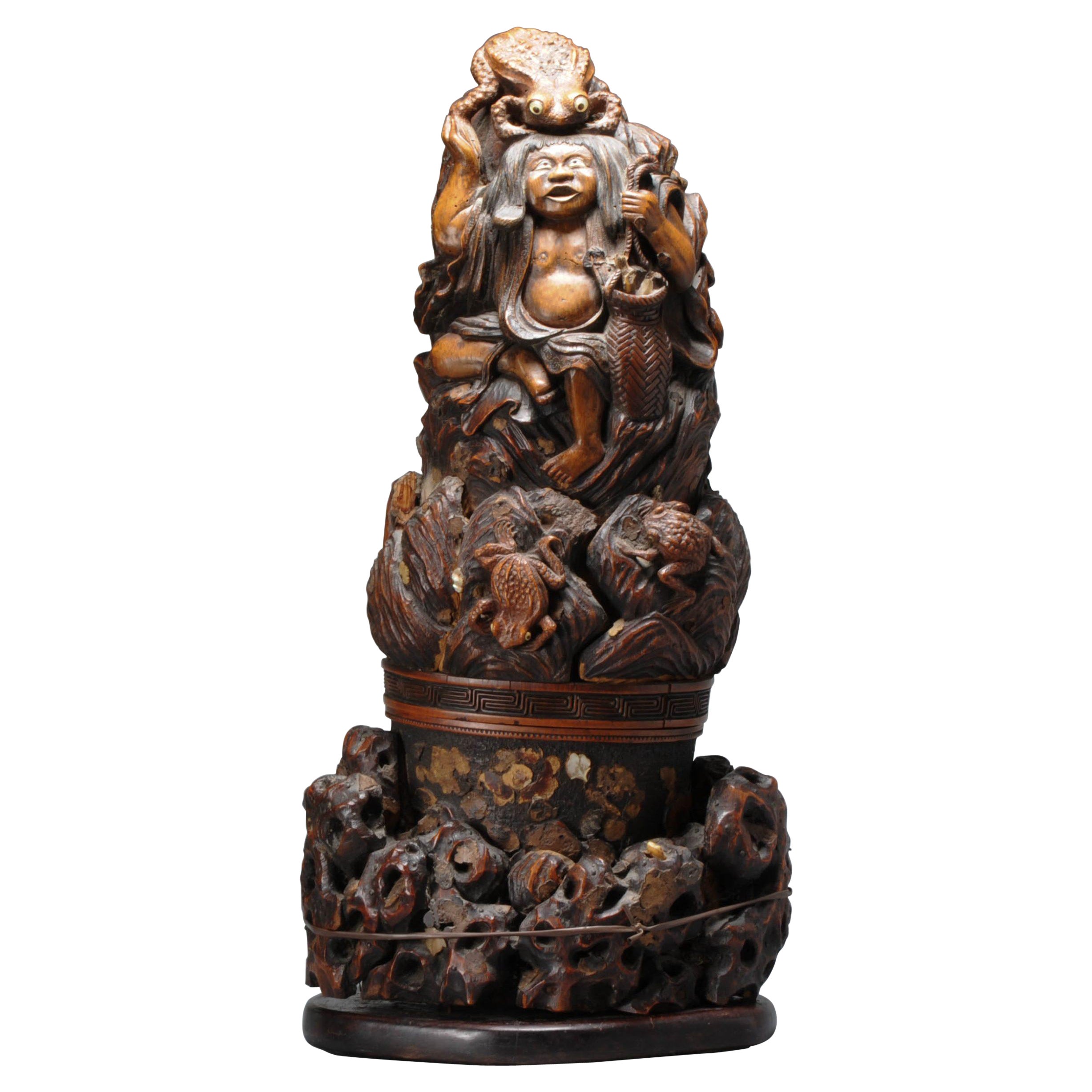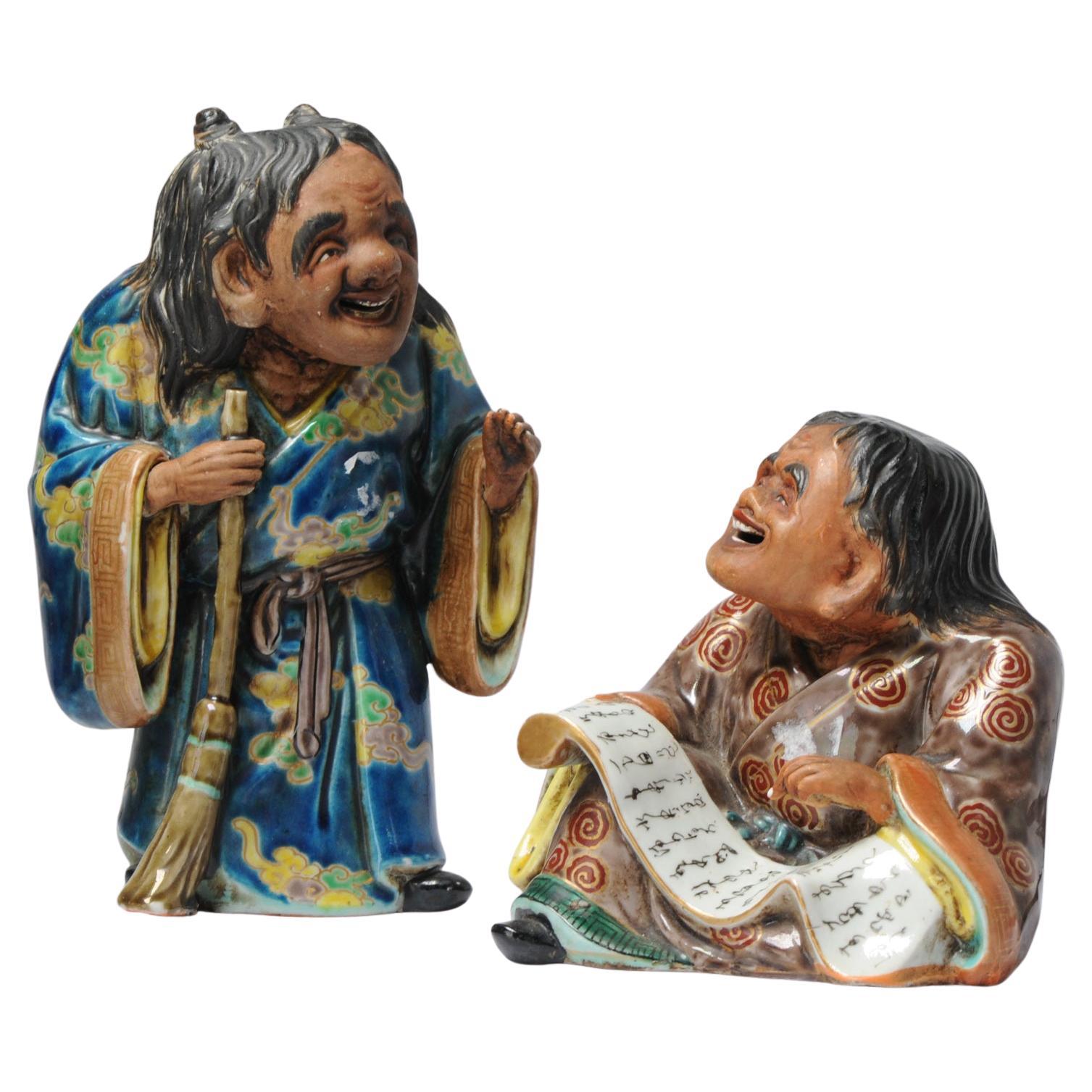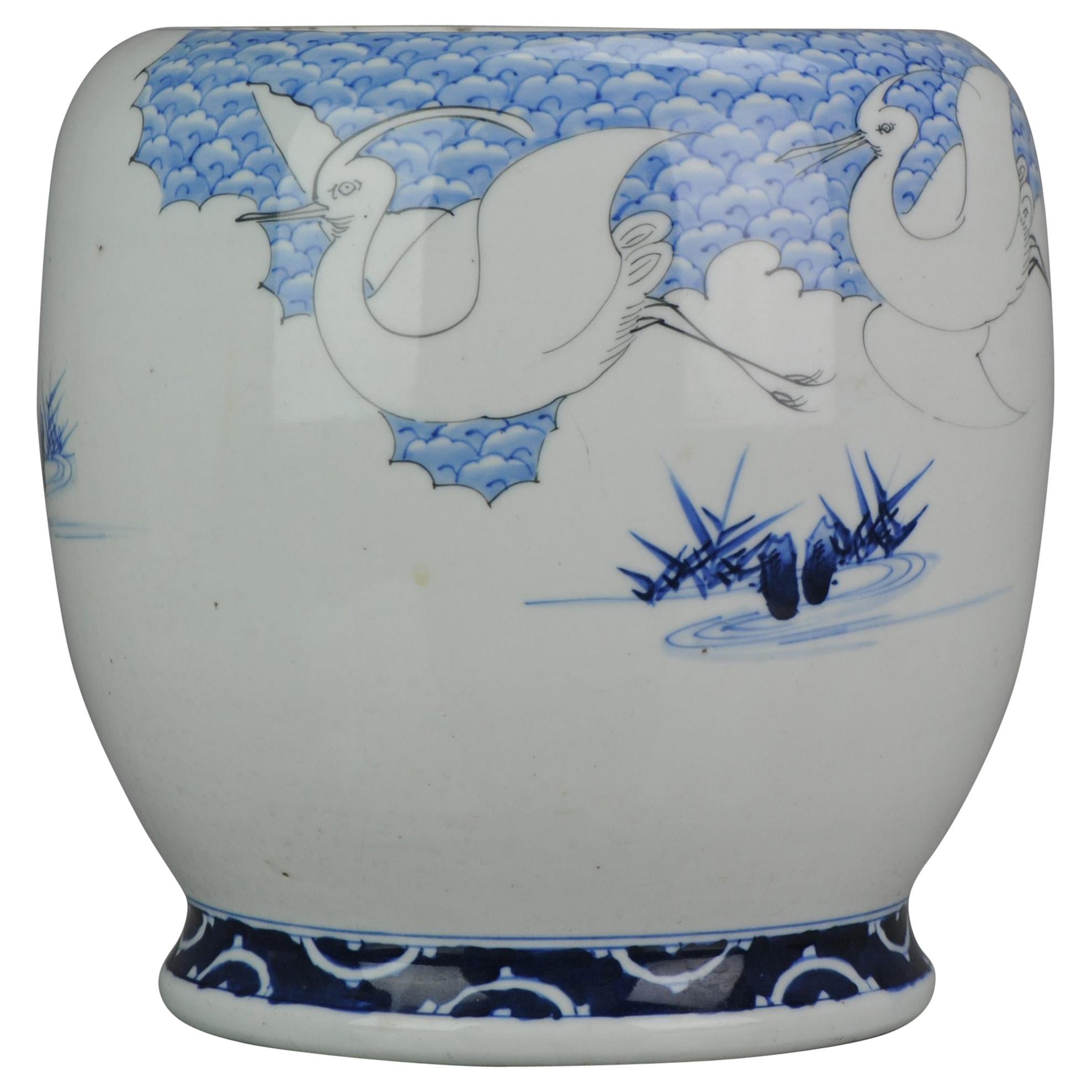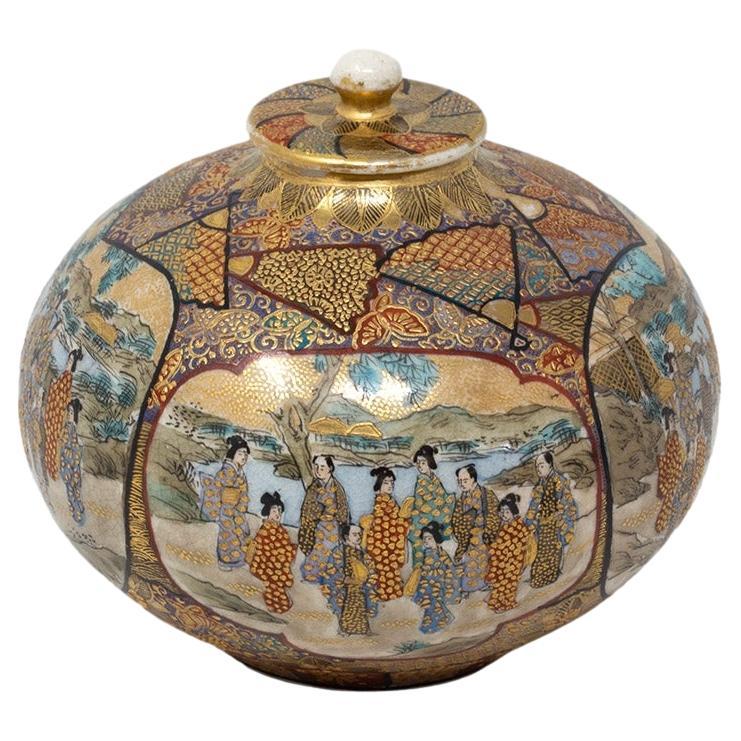Items Similar to Large Antique Edo/Meiji Period 19C Japanese Porcelain Koro Liu Hai Toad
Want more images or videos?
Request additional images or videos from the seller
1 of 20
Large Antique Edo/Meiji Period 19C Japanese Porcelain Koro Liu Hai Toad
About the Item
Large, lovely and very nicely handcrafted.
An unusual large enameled Koro of Liu Hai seated atop a massive three-legged toad with raised lumps on its skin. The immortal dressed in robes tied at the waist and left open exposing his chest. He has an animated expression on his face and lovely colored robes.
Liu Hai
God of Wealth Liu Haior Liu Haichan is another Daoist god of wealth often depicted with a string of coins and accompanied with a three legged toad. Various tales are told about him. The magical toad was said to be able to transport him anywhere he wished. He may have been an official during the Jin dynasty and actually an alchemist called Liu Xuanying. China has some large toad statues that are associated with wealth and many people offer coins for good luck.
Three legged Toad Symbol of the unattainable and of money making.
Condition
Overall condition: 2 legs of the taod restuck and 2 with damage. Liu has 1 frit/chip to body. Size 205×200×150 mm Height x Long x Wide
Period
Meiji Periode (1867-1912).
- Dimensions:Height: 0.04 in (1 mm)Diameter: 0.04 in (1 mm)
- Style:Meiji (Of the Period)
- Materials and Techniques:
- Place of Origin:
- Period:
- Date of Manufacture:19th Century
- Condition:Overall Condition: 2 legs of the taod restuck and 2 with damage. Liu has 1 frit/chip to body. Size 205×200×150 mm HeightxLongxWide.
- Seller Location:Amsterdam, NL
- Reference Number:1stDibs: LU4863222955342
About the Seller
5.0
Gold Seller
These expertly vetted sellers are highly rated and consistently exceed customer expectations.
Established in 2015
1stDibs seller since 2019
158 sales on 1stDibs
Typical response time: 11 hours
- ShippingRetrieving quote...Ships From: Amsterdam, Netherlands
- Return PolicyA return for this item may be initiated within 14 days of delivery.
More From This SellerView All
- Antique Meiji Period 19th Century Japanese Kobako Okimono Liu Hai TOadLocated in Amsterdam, Noord HollandThis is the most unusually made antique Kobako / Okimono we have had It shows Liu Hai the Alchemist with Chan Chu, the tree-legged toad who taught him the sec...Category
Antique 19th Century Japanese Qing Ceramics
MaterialsPorcelain
- Lovely 19c Antique Meiji Period Japanese Koro Bronze CloisonneLocated in Amsterdam, Noord HollandDescription Lovely and beautifully made piece. Provenance: Originally part of the Catherina collection of Japanese bronzes and cloisonne that was partly auctioned in Amsterd...Category
Antique 19th Century Japanese Meiji Ceramics
MaterialsBronze
- Antique Edo/Meiji Period 19C Japanese Kutani Statue Jittoku & KanzanLocated in Amsterdam, Noord HollandDescription Large, lovely and very nicely made Kutani statues It's a moulded porcelain statue with underglaze blue decoration, depicting the ancient Chinese mythical figure of Shide ( Jittoku in Japanese) holding a broom. Jittoku's name literally means "the Foundling". Jittoku was a foster child in the care of a nearby Buddhist monastery, where he swept the kitchen floors...Category
Antique 19th Century Japanese Meiji Ceramics
MaterialsPorcelain
- Antique Edo/Meiji Porcelain 19C Japanese Hirado Crane Jardinere or HandwarmerLocated in Amsterdam, Noord HollandLarge, lovely and very nicely handcrafted piece of large porcelain. Rare. Similar pieces are pictured in "Louis Lawrence : Hirado Prince of Porcelains" Condition some minimal ag...Category
Antique 19th Century Japanese Meiji Ceramics
MaterialsPorcelain
- Large Arita Bowl Beautifull Japanese Porcelain 19th Century Edo/Meiji PeriodLocated in Amsterdam, Noord HollandA very nice Arita Meiji bowl 11-2-20-1-4 Condition Overall condition perfect. Size: 238mm Period 18th century.Category
Antique 19th Century Japanese Meiji Ceramics
MaterialsEarthenware
- Antique Japanese Satsuma Mini Koro Incense Burner Japan Meiji PeriodLocated in Amsterdam, Noord HollandDescription: Fabulous Japanese Satsuma koros. Small red marks on both lid and koro, 19th century. Condition: Overall condition perfect. Size: 85 x 80mm H x D Period: Meiji P...Category
Antique 19th Century Japanese Meiji Ceramics
MaterialsEarthenware
You May Also Like
- Japanese Meiji Period Satsuma KoroBy KinkozanLocated in Newark, EnglandBulbous Form From our Japanese collection, we are delighted to offer this Japanese Meiji Period Satsuma Koro. The Japanese Satsuma Koro of rounded form neatly potted with a small to...Category
Antique Early 1900s Japanese Meiji Ceramics
MaterialsCeramic, Earthenware, Pottery
- Antique Japanese Meiji Period Satsuma Koro KizanLocated in Newark, EnglandMeiji Period (1868-1912) From our Japanese collection, we are pleased to offer this Antique Japanese Meiji Period Satsuma Koro by Kizan. The Koro of squat bombe form raised upon an...Category
Antique 1890s Japanese Meiji Ceramics
MaterialsCeramic, Earthenware
- Large Japanese Imari Charger, Edo/Meiji Period, mid 19th century, JapanLocated in Austin, TXA large 18.25" diameter Japanese Imari porcelain charger, Edo to Meiji Period, mid 19th century, Japan. The large charger of near flattened form and decorated in the typical Imari palette of underglaze blue with red, orange and green overglaze enamels and gilt highlights. The design is centered on a roundel with a dense design of scrolling peony blossoms and leaves in underglaze blue. Two large pictorial reserves of Shinto priests...Category
Antique Mid-19th Century Japanese Meiji Ceramics
MaterialsPorcelain
- Large Japanese Imari Fluted Charger, Edo/Meiji Period, Mid 19th Century, JapanLocated in Austin, TXA large and impressive Japanese Imari porcelain fluted charger with scalloped rim, signed Kaji(chu?), Edo to Meiji Period, mid 19th century, Japan. The magnificent Japanese Imari charger measures 25" in diameter, and is decorated in the typical imari palette of underglaze blue with overglaze red, orange, blue, and green enamels with gilt highlights. The large charger also features fluted sides and a scalloped gilt rim. The design of the charger is centered on a central floral medallion with three large chrysanthemum blossoms and vegetal scrolls. Radiating out from the central medallion are various brocade patterned sections that roughly follow the shape of the fluting. Some larger sections feature images of cranes and minogame (turtles with long tails), both symbols of longevity, while other feature dragons and phoenix, symbols of authority and power. Four large reserves depict charming scenes of a scholar and his students within a bamboo grove having discourse and examining scrolls. The back of the charger decorated in underglaze blue with bold floral and vegetal scrolls. With a three character inscription in underglaze blue reading Kaji(chu?) Sei. The charger is fitted with an antique metal hanger...Category
Antique Mid-19th Century Japanese Meiji Ceramics
MaterialsPorcelain
- Large Japanese Imari Charger 16", Edo / Meiji Period, mid 19th century, JapanLocated in Austin, TXA large and charming Japanese imari charger with Chinese boys, Edo to Meiji Period, mid 19th century, Japan. The large porcelain charger measuring 16" in diameter features high, slo...Category
Antique 1860s Japanese Meiji Ceramics
MaterialsPorcelain
- Japanese Satsuma Incense Burner, Koro, Meiji Period, Late 19th Century, JapanLocated in Austin, TXA fine and elegant Japanese Satsuma tripod incense burner, koro, with pierced metal lid, signed Eizan (?) Meiji Period, late 19th century, Japan. The koro, or censer, features a stoneware body of slightly compressed globular form, supported on three short and squat legs. The wide mouth with a recessed metal rim, and topped by an openwork metal lid topped with overlapping chrysanthemum blossoms of silver repousse. The body of the koro finely painted with fan shaped cartouches. The fans in the foreground with sprays of blossoming chrysanthemum. The fans in the background with intricate geometric brocade designs. The shoulder of the incense burner decorated with cartouches formed as stylized chrysanthemum petals, and intricately decorated with geometric and floral brocade designs. The painting finely done in raised gilt and polychrome enamels, including the highly desirable gosu blue...Category
Antique Late 19th Century Japanese Meiji Ceramics
MaterialsSilver, Metal
Recently Viewed
View AllMore Ways To Browse
Japanese Ceramics Edo Period Or Earlier
Japanese Large Antiques
Japanese Chest On Chest
Meiji Period Ceramics
19th Japanned Chest
The Immortals
19th Century Japanese Chest
Meiji Period Porcelain
Antique Porcelain Symbols
Statue Japan
Good Luck Asian
19th Century Large Japanese Porcelain
Japanese Luck
Antique Japanese Chests
Enamel Coins
Meiji China
Chinese Porcelain Seat
Antique Asian Furniture Chests





